Genome Mining and Analysis of PKS Genes in Eurotium cristatum E1 Isolated from Fuzhuan Brick Tea
Abstract
:1. Introduction
2. Materials and Methods
2.1. Strains, Growth Conditions and Genomic DNA Extraction
2.2. Genome Sequencing, Assembly and Annotation
2.3. Phylogenetic Relationships and Comparative Genomic Analysis
2.4. Identification of Biosynthetic Gene Clusters
2.5. Identification of Polyketide Synthase Genes
2.6. The Relative Expression Level Analysis of PKS Genes
2.7. Analysis of Secondary Metabolites Produced by Eurotium cristatum E1
2.8. Comparison of Emodin and Flavoglaucin Gene Clusters
3. Results
3.1. The Basic Information of Whole Genome
3.2. Phylogenetic Relationships and Comparative Genomic Analysis
3.3. Analysis the Biosynthesis Gene Clusters of Secondary Metabolites
3.4. Genomic Distribution of PKS Genes
3.5. The Relative Expression Level Analysis of PKS Genes
3.6. Detection of Secondary Metabolites Produced by Eurotium cristatum E1
3.7. Putative Emodin Biosynthetic Gene Cluster in Eurotium cristatum E1
3.8. Putative Flavoglaucin Biosynthetic Gene Cluster in Eurotium cristatum E1
4. Discussion
Supplementary Materials
Author Contributions
Funding
Institutional Review Board Statement
Informed Consent Statement
Data Availability Statement
Acknowledgments
Conflicts of Interest
References
- Zheng, W.; Wan, X.; Bao, G. Brick dark tea: A review of the manufacture, chemical constituents and bioconversion of the major chemical components during fermentation. Phytochem. Rev. 2015, 14, 499–523. [Google Scholar] [CrossRef]
- Ren, C.G. Metabolomics reveals changes in metabolite concentrations and correlations during sexual development of Eurotium cristatum (synonym: Aspergillus cristatus). Mycosphere 2017, 8, 1626–1639. [Google Scholar] [CrossRef]
- Liu, G.; Duan, Z.; Wang, P.; Fan, D.; Zhu, C. Purification, characterization, and hypoglycemic properties of eurocristatine from Eurotium cristatum spores in Fuzhuan brick tea. RSC Adv. 2020, 10, 22234–22241. [Google Scholar] [CrossRef]
- Rui, Y.; Wan, P.; Chen, G.; Xie, M.; Sun, Y.; Zeng, X.; Liu, Z. Analysis of bacterial and fungal communities by Illumina MiSeq platforms and characterization of Aspergillus cristatus in Fuzhuan brick tea. Lwt 2019, 110, 168–174. [Google Scholar] [CrossRef]
- Xu, A.; Wang, Y.; Wen, J.; Liu, P.; Liu, Z.; Li, Z. Fungal community associated with fermentation and storage of Fuzhuan brick-tea. Int. J. Food Microbiol. 2011, 146, 14–22. [Google Scholar] [CrossRef]
- Li, Q.; Huang, J.; Li, Y.; Zhang, Y.; Luo, Y.; Chen, Y.; Lin, H.; Wang, K.; Liu, Z. Fungal community succession and major components change during manufacturing process of Fu brick tea. Sci. Rep. 2017, 7, 6407. [Google Scholar] [CrossRef]
- Qi, Z.T.; Sun, Z.M. Identification of predominant species in brick tea. Acta Mycol. Sin. 1990, 9, 176–179. [Google Scholar]
- Zhang, L.; Zhang, Z.; Zhou, Y.; Ling, T.; Wan, X. Chinese dark teas: Postfermentation, chemistry and biological activities. Food Res. Int. 2013, 53, 600–607. [Google Scholar] [CrossRef]
- Fu, D.; Ryan, E.P.; Huang, J.; Liu, Z.; Weir, T.L.; Snook, R.L.; Ryan, T.P. Fermented Camellia sinensis, Fu Zhuan Tea, regulates hyperlipidemia and transcription factors involved in lipid catabolism. Food Res. Int. 2011, 44, 2999–3005. [Google Scholar] [CrossRef]
- Cox, R.J.; Skellam, E.; Williams, K. Biosynthesis of Fungal Polyketides. In Physiology and Genetics. The Mycota (A Comprehensive Treatise on Fungi as Experimental Systems for Basic and Applied Research); Anke, T., Schüffler, A., Eds.; Springer: Cham, Switzerland, 2018; Volume 15. [Google Scholar] [CrossRef]
- Wiemann, P.; Guo, C.J.; Palmer, J.M.; Sekonyela, R.; Wang, C.C.; Keller, N.P. Prototype of an intertwined secondary-metabolite supercluster. Proc. Natl. Acad. Sci. USA 2013, 110, 17065–17070. [Google Scholar] [CrossRef] [Green Version]
- Shi, J.; Liu, J.; Kang, D.; Huang, Y.; Kong, W.; Xiang, Y.; Zhu, X.; Duan, Y.; Huang, Y. Isolation and Characterization of Benzaldehyde Derivatives with Anti-Inflammatory Activities from Eurotium cristatum, the Dominant Fungi Species in Fuzhuan Brick Tea. ACS Omega 2019, 4, 6630–6636. [Google Scholar] [CrossRef]
- Zou, X.; Li, Y.; Zhang, X.; Li, Q.; Liu, X.; Huang, Y.; Tang, T.; Zheng, S.; Wang, W.; Tang, J. A new prenylated indole diketopiperazine alkaloid from Eurotium cristatum. Molecules 2014, 19, 17839–17847. [Google Scholar] [CrossRef]
- Peng, X.; Liang, F.; Li, D.; Chen, Y.; Tao, M.; Zhang, W.; Yunlin, Z. Secondary metabolites of Eurotium cristatum from Fu Brick Tea and their biological activities. Chin. Tradit. Herb. Drugs 2013, 44, 1881–1886. [Google Scholar]
- Slack, G.J.; Puniani, E.; Frisvad, J.C.; Samson, R.A.; Miller, J.D. Secondary metabolites from Eurotium species, Aspergillus calidoustus and A. insuetus common in Canadian homes with a review of their chemistry and biological activities. Mycol Res. 2009, 113, 480–490. [Google Scholar] [CrossRef]
- Liu, Q.; Xie, N.; He, Y.; Wang, L.; Shao, Y.; Zhao, H.; Chen, F. MpigE, a gene involved in pigment biosynthesis in Monascus ruber M7. Appl. Microbiol. Biotechnol. 2013, 98, 285–296. [Google Scholar] [CrossRef]
- Wingett, S.W.; Andrews, S. FastQ Screen: A tool for multi-genome mapping and quality control. F1000Res 2018, 7, 1338. [Google Scholar] [CrossRef]
- Ardui, S.; Ameur, A.; Vermeesch, J.R.; Hestand, M.S. Single molecule real-time (SMRT) sequencing comes of age: Applications and utilities for medical diagnostics. Nucleic Acids Res. 2018, 46, 2159–2168. [Google Scholar] [CrossRef] [Green Version]
- Stanke, M.; Diekhans, M.; Baertsch, R.; Haussler, D. Using native and syntenically mapped cDNA alignments to improve de novo gene finding. Bioinformatics 2008, 24, 637–644. [Google Scholar] [CrossRef] [Green Version]
- Sayers, E.W.; Bolton, E.E.; Brister, J.R.; Canese, K.; Chan, J.; Comeau, D.C.; Connor, R.; Funk, K.; Kelly, C.; Kim, S.; et al. Database resources of the national center for biotechnology information. Nucleic Acids Res. 2022, 50, D20–D26. [Google Scholar] [CrossRef]
- Tamura, K.; Peterson, D.; Peterson, N.; Stecher, G.; Nei, M.; Kumar, S. MEGA5: Molecular evolutionary genetics analysis using maximum likelihood, evolutionary distance, and maximum parsimony methods. Mol. Biol. Evol. 2011, 28, 2731–2739. [Google Scholar] [CrossRef] [Green Version]
- Emms, D.M.; Kelly, S. OrthoFinder: Phylogenetic orthology inference for comparative genomics. Genome Biol. 2019, 20, 238. [Google Scholar] [CrossRef] [PubMed] [Green Version]
- Darling, A.C.; Mau, B.; Blattner, F.R.; Perna, N.T. Mauve: Multiple alignment of conserved genomic sequence with rearrangements. Genome Res. 2004, 14, 1394–1403. [Google Scholar] [CrossRef] [PubMed] [Green Version]
- Blin, K.; Shaw, S.; Steinke, K.; Villebro, R.; Ziemert, N.; Lee, S.Y.; Medema, M.H.; Weber, T. antiSMASH 5.0: Updates to the secondary metabolite genome mining pipeline. Nucleic Acids Res. 2019, 47, W81–W87. [Google Scholar] [CrossRef] [Green Version]
- Medema, M.H.; Kottmann, R.; Yilmaz, P.; Cummings, M.; Biggins, J.B.; Blin, K.; de Bruijn, I.; Chooi, Y.H.; Claesen, J.; Coates, R.C.; et al. Minimum Information about a Biosynthetic Gene cluster. Nat. Chem. Biol. 2015, 11, 625–631. [Google Scholar] [CrossRef]
- Mistry, J.; Chuguransky, S.; Williams, L.; Qureshi, M.; Salazar, G.A.; Sonnhammer, E.L.L.; Tosatto, S.C.E.; Paladin, L.; Raj, S.; Richardson, L.J.; et al. Pfam: The protein families database in 2021. Nucleic Acids Res. 2021, 49, D412–D419. [Google Scholar] [CrossRef] [PubMed]
- Cameron, L.M. Gilchrist. gamcil/synthaser: Synthaser v1.1.0 (v1.1.0). Zenodo 2020. [Google Scholar] [CrossRef]
- Chen, W.; Chen, R.; Liu, Q.; He, Y.; He, K.; Ding, X.; Kang, L.; Guo, X.; Xie, N.; Zhou, Y.; et al. Orange, red, yellow: Biosynthesis of azaphilone pigments in Monascus fungi. Chem. Sci. 2017, 8, 4917–4925. [Google Scholar] [CrossRef] [Green Version]
- Gilchrist, C.L.M.; Chooi, Y.H. Clinker & clustermap.js: Automatic generation of gene cluster comparison figures. Bioinformatics 2021, 37, 2473–2475. [Google Scholar] [CrossRef]
- Dohra, H.; Tanaka, K.; Suzuki, T.; Fujishima, M.; Suzuki, H. Draft genome sequences of three Holospora species (Holospora obtusa, Holospora undulata, and Holospora elegans), endonuclear symbiotic bacteria of the ciliate Paramecium caudatum. FEMS Microbiol. Lett. 2014, 359, 16–18. [Google Scholar] [CrossRef] [Green Version]
- Ge, Y.; Wang, Y.; Liu, Y.; Tan, Y.; Ren, X.; Zhang, X.; Hyde, K.D.; Liu, Y.; Liu, Z. Comparative genomic and transcriptomic analyses of the Fuzhuan brick tea-fermentation fungus Aspergillus cristatus. BMC Genom. 2016, 17, 1–13. [Google Scholar] [CrossRef] [Green Version]
- He, Y.; Wang, B.; Chen, W.; Cox, R.J.; He, J.; Chen, F. Recent advances in reconstructing microbial secondary metabolites biosynthesis in Aspergillus spp. Biotechnol. Adv. 2018, 36, 739–783. [Google Scholar] [CrossRef]
- van Dijk, J.W.A.; Guo, C.-J.; Wang, C.C.C. Engineering Fungal Nonribosomal Peptide Synthetase-like Enzymes by Heterologous Expression and Domain Swapping. Org. Lett. 2016, 18, 6236–6239. [Google Scholar] [CrossRef]
- Schor, R.; Cox, R. Classic fungal natural products in the genomic age: The molecular legacy of Harold Raistrick. Nat. Product Rep. 2018, 35, 230–256. [Google Scholar] [CrossRef] [Green Version]
- Throckmorton, K.; Lim, F.Y.; Kontoyiannis, D.P.; Zheng, W.; Keller, N.P. Redundant synthesis of a conidial polyketide by two distinct secondary metabolite clusters in Aspergillus fumigatus. Environ. Microbiol. 2016, 18, 246–259. [Google Scholar] [CrossRef] [Green Version]
- Virolle, M.-J.; Nielsen, M.T.; Nielsen, J.B.; Anyaogu, D.C.; Holm, D.K.; Nielsen, K.F.; Larsen, T.O.; Mortensen, U.H. Heterologous Reconstitution of the Intact Geodin Gene Cluster in Aspergillus nidulans through a Simple and Versatile PCR Based Approach. PLoS ONE 2013, 8, e72871. [Google Scholar]
- Sanchez, J.F.; Entwistle, R.; Hung, J.-H.; Yaegashi, J.; Jain, S.; Chiang, Y.-M.; Wang, C.C.C.; Oakley, B.R. Genome-Based Deletion Analysis Reveals the Prenyl Xanthone Biosynthesis Pathway in Aspergillus nidulans. J. Am. Chem. Soc. 2011, 133, 4010–4017. [Google Scholar] [CrossRef] [Green Version]
- Chiang, Y.-M.; Szewczyk, E.; Davidson, A.D.; Entwistle, R.; Keller, N.P.; Wang, C.C.C.; Oakley, B.R. Characterization of the Aspergillus nidulans Monodictyphenone Gene Cluster. Appl. Environ. Microbiol. 2010, 76, 2067–2074. [Google Scholar] [CrossRef] [Green Version]
- Allen, J.K.; Barrow, K.D.; Jones, A.J.; Hanisch, P. Biosynthesis of Flavoglaucin. Stereochemistry of Aromatic Isoprenylation. J. Chem. Soc. Perkin Trans. 1978, 1, 152–154. [Google Scholar] [CrossRef]
- Nies, J.; Ran, H.; Wohlgemuth, V.; Yin, W.B.; Li, S.M. Biosynthesis of the Prenylated Salicylaldehyde Flavoglaucin Requires Temporary Reduction to Salicyl Alcohol for Decoration before Reoxidation to the Final Product. Org. Lett. 2020, 22, 2256–2260. [Google Scholar] [CrossRef]
- Miyake, Y.; Ito, C.; Tokuda, H.; Osawa, T.; Itoigawa, M. Evaluation of flavoglaucin, its derivatives and pyranonigrins produced by molds used in fermented foods for inhibiting tumor promotion. Biosci. Biotechnol. Biochem. 2010, 74, 1120–1122. [Google Scholar] [CrossRef] [Green Version]
- Nguyen, C.T.; Bridget, A.F.; Pham, V.T.T.; Nguyen, H.T.; Kim, T.S.; Sohng, J.K. Genome mining Streptomyces sp. KCTC 0041BP as a producer of dihydrochalcomycin. Appl. Microbiol. Biotechnol. 2021, 105, 5023–5037. [Google Scholar] [CrossRef] [PubMed]
- Varadarajan, A.R.; Allan, R.N.; Valentin, J.D.P.; Castañeda Ocampo, O.E.; Somerville, V.; Pietsch, F.; Buhmann, M.T.; West, J.; Skipp, P.J.; van der Mei, H.C.; et al. An integrated model system to gain mechanistic insights into biofilm-associated antimicrobial resistance in Pseudomonas aeruginosa MPAO1. Npj Biofilms Microbiomes 2020, 6, 1–17. [Google Scholar] [CrossRef] [PubMed]
- Reva, O.N.; Larisa, S.A.; Mwakilili, A.D.; Tibuhwa, D.; Lyantagaye, S.; Chan, W.Y.; Lutz, S.; Ahrens, C.H.; Vater, J.; Borriss, R. Complete genome sequence and epigenetic profile of Bacillus velezensis UCMB5140 used for plant and crop protection in comparison with other plant-associated Bacillus strains. Appl. Microbiol. Biotechnol. 2020, 104, 7643–7656. [Google Scholar] [CrossRef] [PubMed]
- Kjaerbolling, I.; Mortensen, U.H.; Vesth, T.; Andersen, M.R. Strategies to establish the link between biosynthetic gene clusters and secondary metabolites. Fungal Genet. Biol. 2019, 130, 107–121. [Google Scholar] [CrossRef]
- Lin, S.H.; Yoshimoto, M.; Lyu, P.C.; Tang, C.Y.; Arita, M. Phylogenomic and Domain Analysis of Iterative polyketide synthases in Aspergillus species. Evol. Bioinform. 2012, 8, 373–387. [Google Scholar] [CrossRef] [Green Version]
- Amnuaykanjanasin, A.; Phonghanpot, S.; Sengpanich, N.; Cheevadhanarak, S.; Tanticharoen, M. Insect-specific polyketide synthases (PKSs), potential PKS-nonribosomal peptide synthetase hybrids, and novel PKS clades in tropical fungi. Appl. Environ. Microbiol. 2009, 75, 3721–3732. [Google Scholar] [CrossRef] [Green Version]
- Frisvad, J.C.; Larsen, T.O. Chemodiversity in the genus Aspergillus. Appl. Microbiol. Biotechnol. 2015, 99, 7859–7877. [Google Scholar] [CrossRef]
- Kong, W.; Huang, C.; Shi, J.; Li, Y.; Jiang, X.; Duan, Q.; Huang, Y.; Duan, Y.; Zhu, X. Recycling of Chinese herb residues by endophytic and probiotic fungus Aspergillus cristatus CB10002 for the production of medicinal valuable anthraquinones. Microb. Cell Fact. 2019, 18, 102. [Google Scholar] [CrossRef]
- Ran, H.; Li, S.M. Fungal benzene carbaldehydes: Occurrence, structural diversity, activities and biosynthesis. Nat. Prod. Rep. 2020, 38, 240–263. [Google Scholar] [CrossRef]
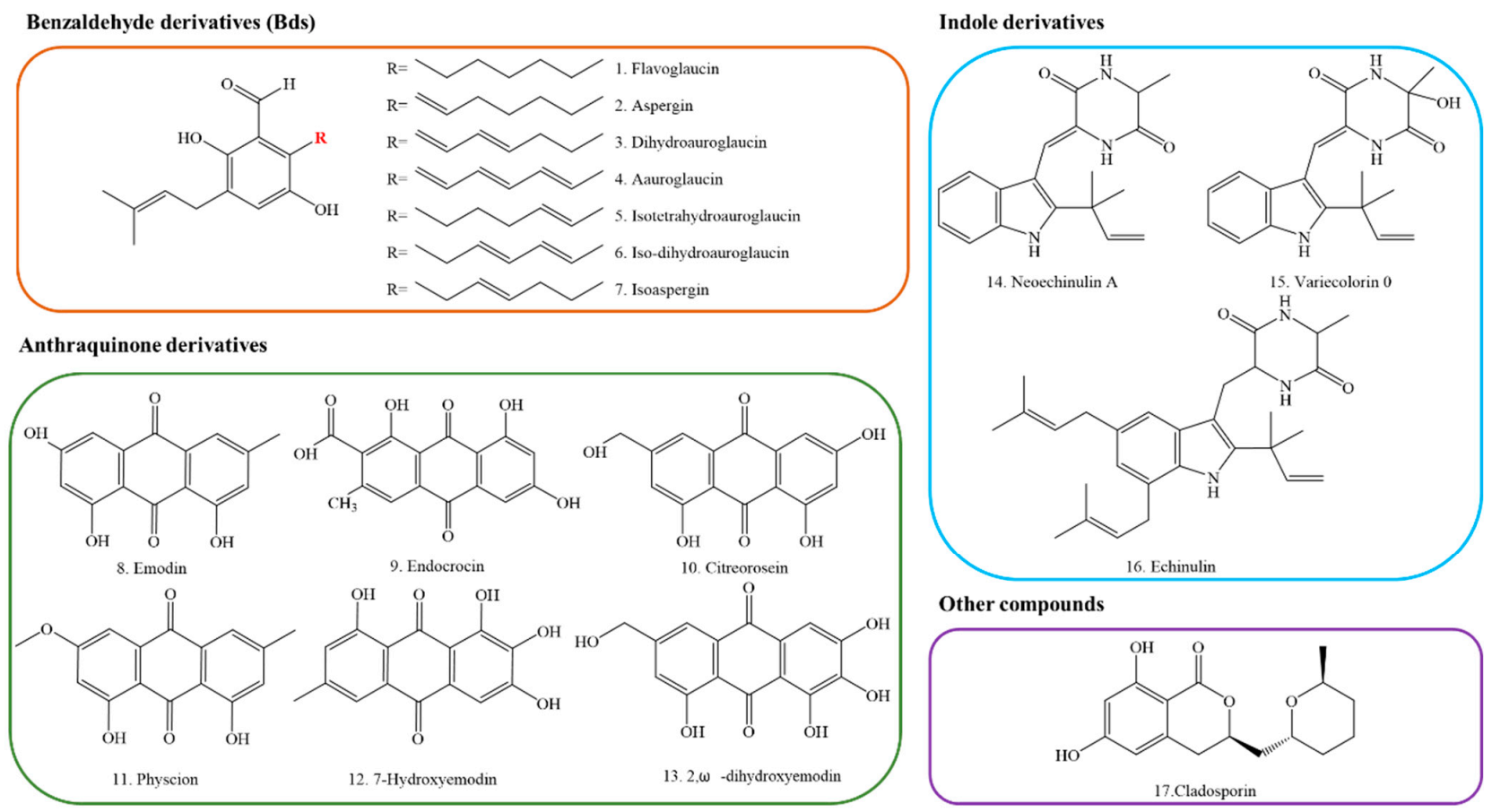
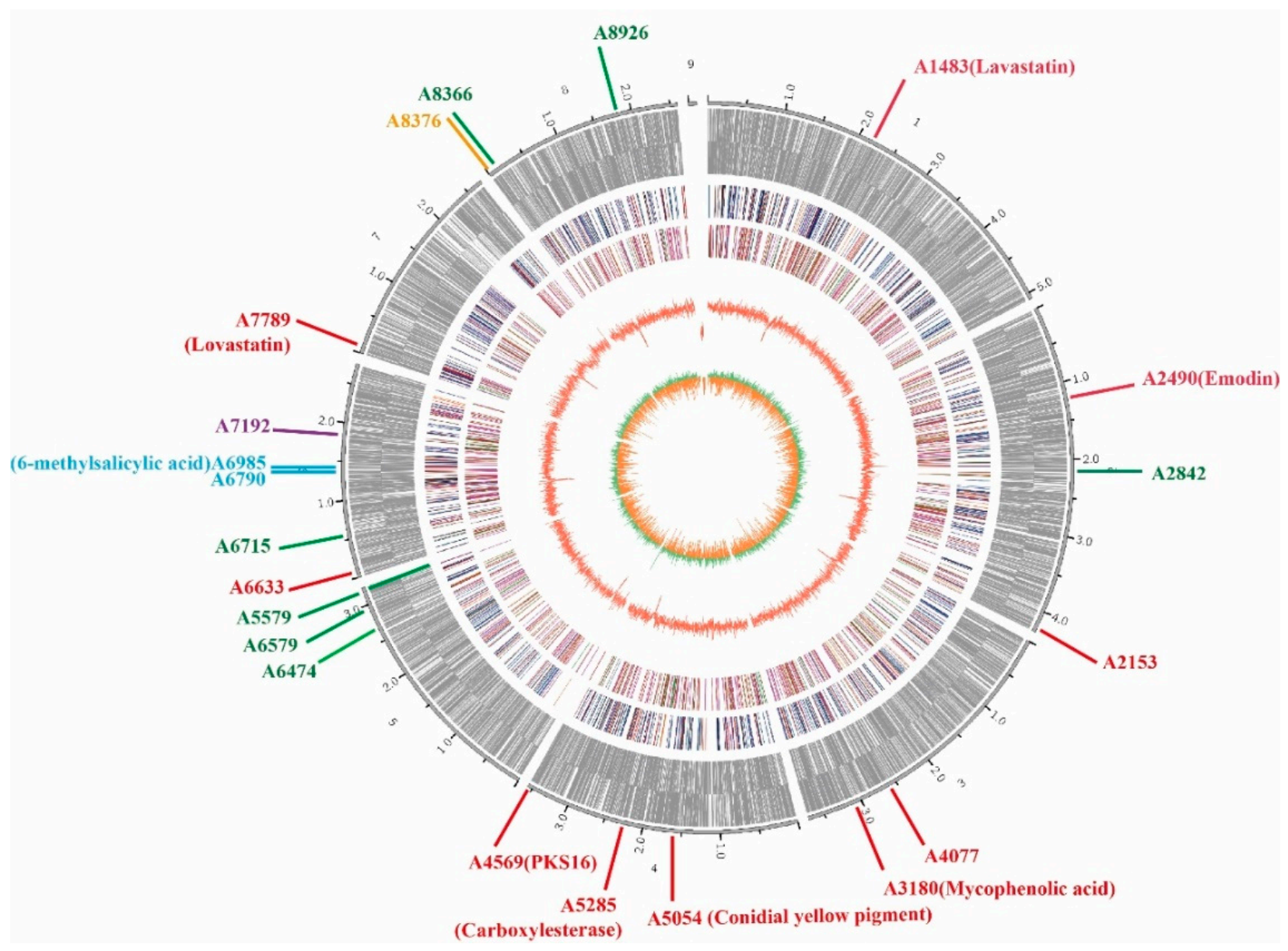
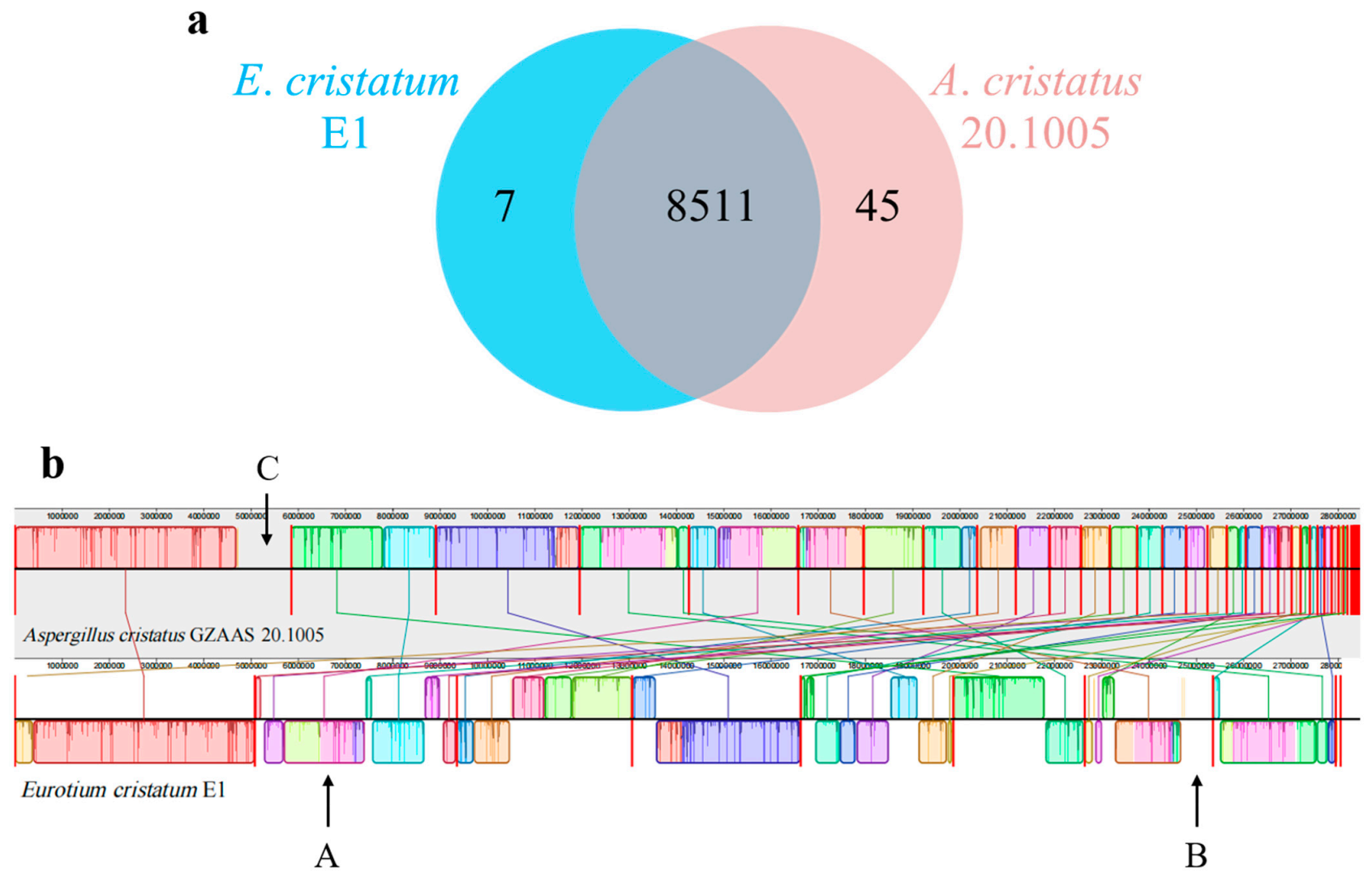
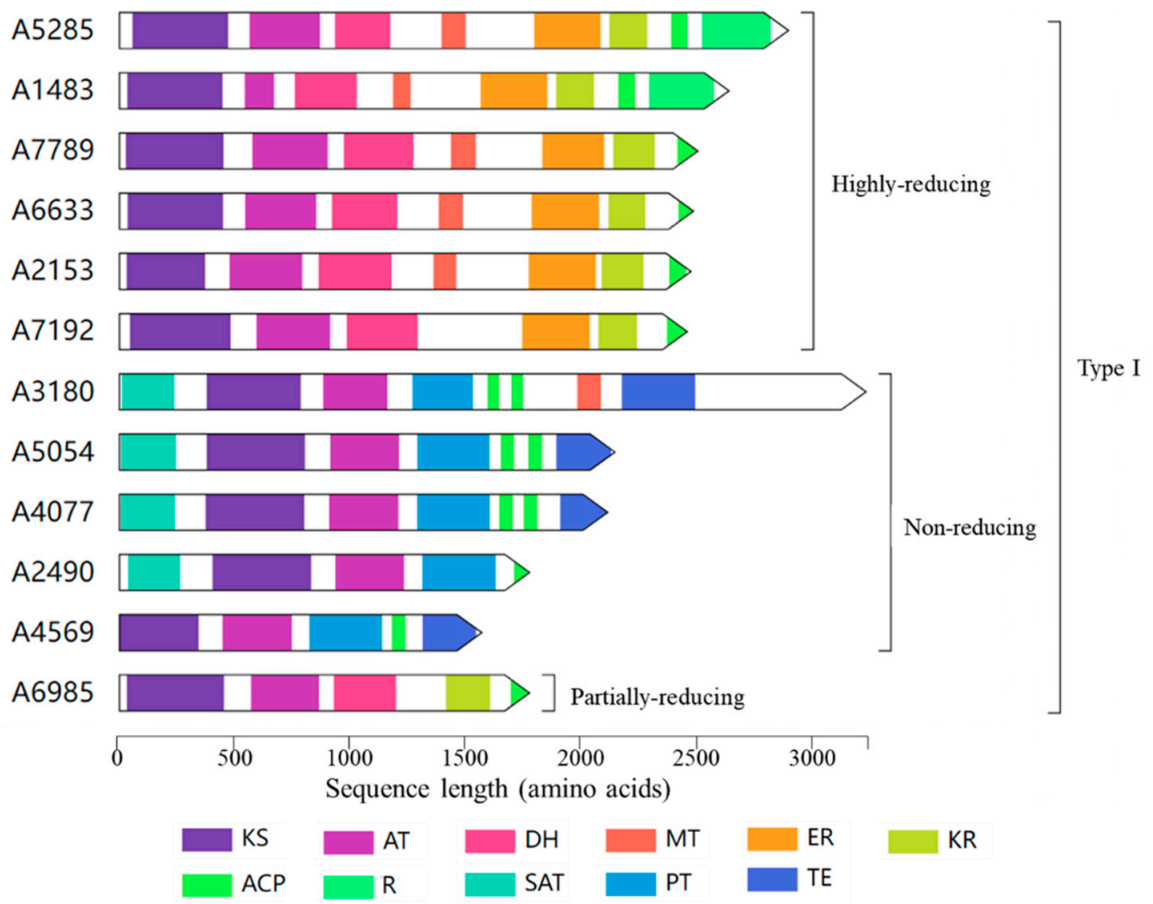
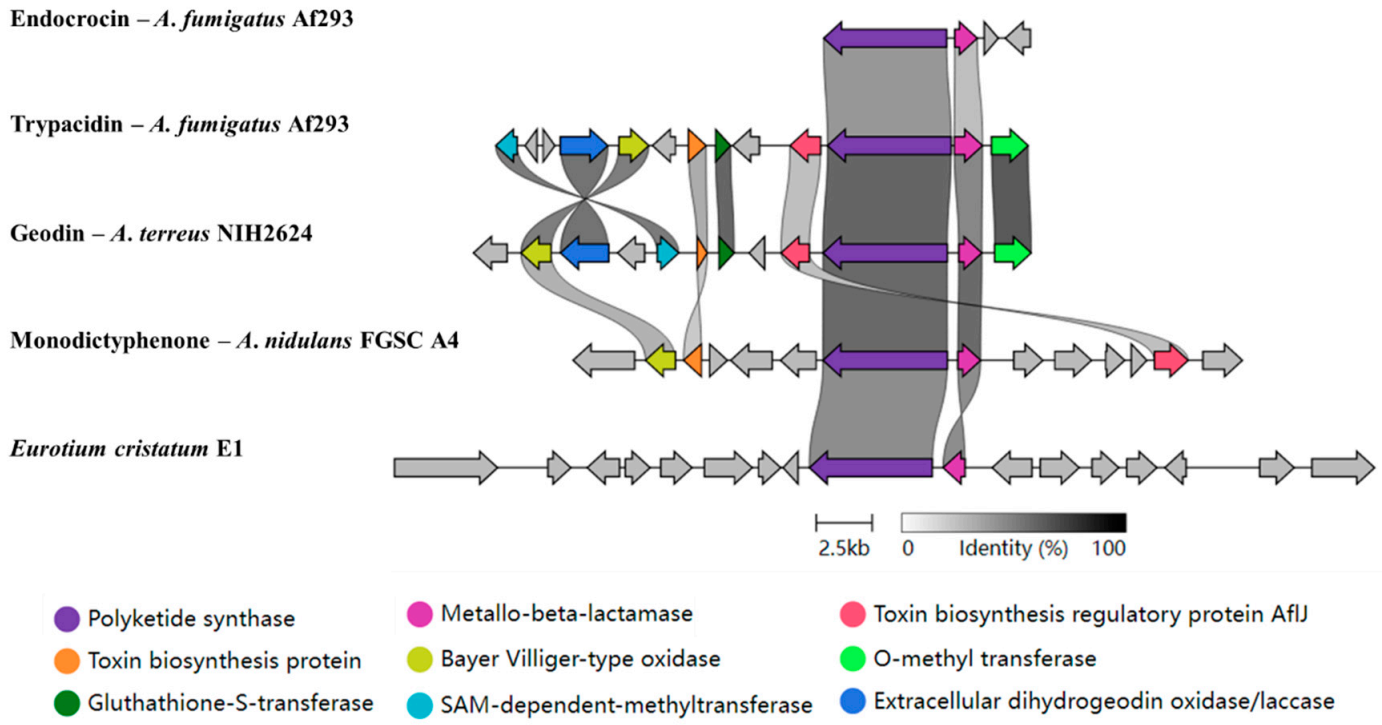

| Genome | E. cristatum E1 | A. cristatus GZAAS 20.1005 |
|---|---|---|
| General information | ||
| Size (Mb) | 28.06 | 27.9 |
| Number of contigs/scaffolds | 9 | 68 |
| N50 (bp) | 3,564,179 | 2,308,221 |
| G + C content (%) | 49.72 | 49.86 |
| Coding (%) | 50.93 | 51.92 |
| Protein-coding genes | 9226 | 10,136 |
| Mean gene length (bp) | 1549 | 1573 |
| Cluster | Contig | Gene Cluster Type | Backbone Enzymes | Predicted Products | Chemical Formulation | Similarity |
|---|---|---|---|---|---|---|
| BGC1 | Contig1 | t1pks | PKS | - | ||
| BGC2 | Contig2 | t1pks | PKS | TAN-1612 | 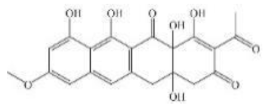 | 60% |
| BGC3 | Contig2 | t1pks | PKS | - | ||
| BGC4 | Contig3 | t1pks | PKS | - | ||
| BGC5 | Contig3 | t1pks | PKS | - | ||
| BGC6 | Contig4 | t1pks | PKS | Naphthopyrone | 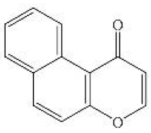 | 100% |
| BGC7 | Contig4 | t1pks | PKS | - | ||
| BGC8 | Contig4 | t1pks | PKS | - | ||
| BGC9 | Contig6 | t1pks | PKS | - | ||
| BGC10 | Contig7 | t1pks | PKS | Cornexistin |  | 9% |
| BGC11 | Contig2 | nrps | NRPS | - | ||
| BGC12 | Contig5 | nrps | NRPS | - | ||
| BGC13 | Contig5 | nrps | NRPS | - | ||
| BGC14 | Contig5 | nrps | NRPS | - | ||
| BGC15 | Contig6 | nrps | NRPS | - | ||
| BGC16 | Contig8 | nrps | NRPS | - | ||
| BGC17 | Contig8 | nrps | NRPS | - | ||
| BGC18 | Contig6 | t1pks-nrps | PKS- NRPS | 6-methylsalicylic acid | 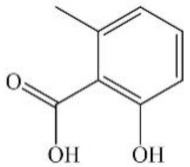 | 100% |
| BGC19 | Contig6 | Indole-t1pks | PKS | Neurosporin A | 20% | |
| BGC20 | Contig8 | Indole-nrps | NRPS | - | ||
| BGC21 | Contig2 | Terpene | - | |||
| BGC22 | Contig5 | Terpene | - | |||
| BGC23 | Contig5 | Terpene | - | |||
| BGC24 | Contig7 | Terpene | - | |||
| BGC25 | Contig8 | Terpene | Clavaric acid | 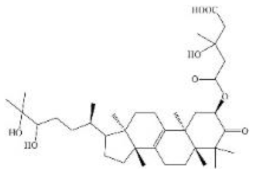 | 66% | |
| BGC26 | Contig3 | Siderophore | - | |||
| BGC27 | Contig3 | Other | - | |||
| BGC28 | Contig3 | Other | - | |||
| BGC29 | Contig3 | Other | - | |||
| BGC30 | Contig3 | Other | - | |||
| BGC31 | Contig4 | Other | - | |||
| BGC32 | Contig5 | Other | - | |||
| BGC33 | Contig6 | Other | - | |||
| BGC34 | Contig8 | Other | - |
| Type | Number | PKS ID | Amino Acids | Homologs and Related Description | Sequence Identity | BGC ID—Scaffold |
|---|---|---|---|---|---|---|
| hrPKS | ||||||
| 1 | A1483 | 2643 | Lovastatin diketide synthase LovF (GenBank: GAQ02995.1) | 54% | BGC01—scaffold1 | |
| 2 | A2153 | 2478 | Beta-ketoacyl synthase (GenBank: CDM30483.1) | 56% | BGC03—scaffold2 | |
| 3 | A5285 | 2901 | Carboxylesterase type B (GenBank: OOO04444.1) | 56% | BGC08—scaffold4 | |
| 4 | A6633 | 2489 | Acyl transferase/acyl hydrolase/lysophospholipase (GenBank: KGO38831.1) | 56% | BGC09—scaffold6 | |
| 5 | A7192 | 2462 | polyketide synthase (GenBank: EYE95336.1) | 93% | BGC19—scaffold6 | |
| 6 | A7789 | 2508 | Lovastatin diketide synthase LovF (GenBank: GAQ05228.1) | 53% | BGC10—scaffold7 | |
| nrPKS | ||||||
| 7 | A2490 | 1778 | Monodictyphenone synthesis protein mdpG (GenBank: Q5BH30.1) | 53% | BGC02—scaffold2 | |
| 8 | A3180 | 3237 | Mycophenolic acid synthesis protein mapC (GenBank: F1DBA9.1) | 46% | BGC04—scaffold3 | |
| 9 | A4077 | 2117 | Beta-ketoacyl synthase N-terminal domain family protein (GenBank: OWW34975.1) | 61% | BGC05—scaffold3 | |
| 10 | A4569 | 1571 | PKS16 protein (GenBank: EYE96821.1) | 76% | BGC06—scaffold4 | |
| 11 | A5054 | 2148 | Conidial yellow pigment biosynthesis polyketide synthase (GenBank: OOQ85606.1) | 71% | BGC07—scaffold4 | |
| prPKS | ||||||
| 12 | A6985 | 1778 | 6-methylsalicylic acid synthase MsaS (GenBank: EYE91246.1) | 88% | BGC18—scaffold6 |
| Num | Compounds | UPLC-MS/MS | UV Chromatogram | ||
|---|---|---|---|---|---|
| m/z ([M + H]+) | m/z ([M − H]−) | m/z | |||
| 1 | Isoaspergin | 303.141 | 301.164 | 302.152 |  |
| 2 | Dihydroauroglaucin | 301.164 | 299.314 | 300.239 |  |
| 3 | Iso-dihydroauroglaucin | 300.59 | 298.932 | 299.761 |  |
| 4 | Aspergin | 303.97 | 301.291 | 302.630 |  |
| 5 | Flavoglaucin | 304.799 | 302.949 | 303.874 |  |
| 6 | Auroglaucin | 299.123 | 297.083 | 298.103 |  |
| 7 | Citreorosein | 286.688 | 284.902 | 285.795 |  |
| 8 | Emodin | 270.681 | 268.959 | 269.82 |  |
| 9 | Physcion | 285.872 | 283.831 | 284.851 |  |
| 10 | Echinulin | 462.297 | 460.129 | 461.213 |  |
Publisher’s Note: MDPI stays neutral with regard to jurisdictional claims in published maps and institutional affiliations. |
© 2022 by the authors. Licensee MDPI, Basel, Switzerland. This article is an open access article distributed under the terms and conditions of the Creative Commons Attribution (CC BY) license (https://creativecommons.org/licenses/by/4.0/).
Share and Cite
Guo, X.; Chen, F.; Liu, J.; Shao, Y.; Wang, X.; Zhou, Y. Genome Mining and Analysis of PKS Genes in Eurotium cristatum E1 Isolated from Fuzhuan Brick Tea. J. Fungi 2022, 8, 193. https://doi.org/10.3390/jof8020193
Guo X, Chen F, Liu J, Shao Y, Wang X, Zhou Y. Genome Mining and Analysis of PKS Genes in Eurotium cristatum E1 Isolated from Fuzhuan Brick Tea. Journal of Fungi. 2022; 8(2):193. https://doi.org/10.3390/jof8020193
Chicago/Turabian StyleGuo, Xiaoxiao, Fusheng Chen, Jiao Liu, Yanchun Shao, Xiaohong Wang, and Youxiang Zhou. 2022. "Genome Mining and Analysis of PKS Genes in Eurotium cristatum E1 Isolated from Fuzhuan Brick Tea" Journal of Fungi 8, no. 2: 193. https://doi.org/10.3390/jof8020193
APA StyleGuo, X., Chen, F., Liu, J., Shao, Y., Wang, X., & Zhou, Y. (2022). Genome Mining and Analysis of PKS Genes in Eurotium cristatum E1 Isolated from Fuzhuan Brick Tea. Journal of Fungi, 8(2), 193. https://doi.org/10.3390/jof8020193








